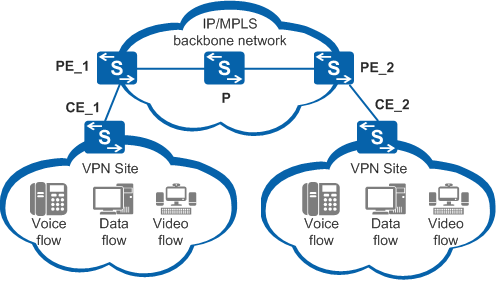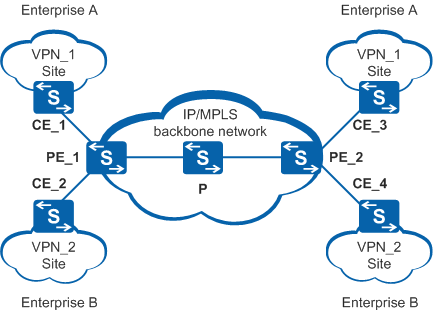Application of MPLS QoS in the VPN Service
With the wide application of the MPLS technology, service providers offer VPN services to enterprises through MPLS networks. VPN is used to connect employees on a business trip, users in remote branches, and partners to the enterprise headquarters. However, VPNs need to effectively transmit enterprise operation data to provide QoS guarantee for enterprise services. For example, bandwidth for applications such as voice and video services must be ensured so that devices can preferentially process voice and video flows. The best effort service applies to services such as World Wide Web (WWW) and email to which timely transmission and reliability cannot be guaranteed.
MPLS QoS can be deployed to meet these requirements.
Differentiating Priorities of Services in a VPN
When different VPN service flows enter an MPLS network, switches on the MPLS network must differentiate priorities of those services to provide differentiated services. In Figure 1, two VPN sites are the branches of the same enterprise. The enterprise network transmits voice, video, and data services, with priorities in a descending order.
Packets carry different precedence fields depending on the network type. For example, packets carry the 802.1p field on a Layer 2 network, the DSCP field on a Layer 3 network, and the EXP field on an MPLS network. In Figure 1, PE_1, P, and PE_2 process packets as follows:
The ingress node PE_1 maps DSCP priorities carried in IP packets to internal priorities and colors. It also provides different QoS services according to the internal priorities and colors. When packets leave PE_1, it re-marks the internal priorities and colors so that switches on the MPLS network can provide differentiated services based on the EXP values.
The transit node P maps EXP values carried in received packets to internal priorities and colors and provides different QoS services according to the internal priorities and colors. When packets leave P, it re-marks EXP values based on the internal priorities and colors.
The egress node PE_2 maps EXP values or DSCP priorities carried in received packets to internal priorities and colors. It also provides different QoS services according to the internal priorities and colors. When packets leave PE_2, it re-marks DSCP priorities based on the internal priorities and colors, so that downstream switches can provide differentiated services based on packet priorities.
Differentiating Priorities of Services for Different VPNs
When service flows enter an MPLS network from different VPNs, switches on the MPLS network must differentiate priorities to ensure preferential forwarding of service flows from higher priority enterprises. The switches provide differentiated services to the service flows based on their priorities.
Figure 2 illustrates the differentiating priorities of services for different VPNs.
CE_1 and CE_3 belong to VPN_1 and connect to two branches of enterprise A. CE_2 and CE_4 belong to VPN_2 and connect to two branches of enterprise B.
Packets carry different precedence fields depending on the network type. For example, packets carry the 802.1p field on a Layer 2 network, the DSCP field on a Layer 3 network, and the EXP field on an MPLS network. In Figure 2, PE_1, P, and PE_2 process packets as follows:
The ingress node PE_1 maps priorities of packets from enterprises A and B to EXP values in a descending order. Therefore, switches on the MPLS network provide differentiated services based on the EXP values.
The transit node P maps EXP values carried in received packets to internal priorities and colors. It also provides different QoS services according to the internal priorities and colors. When packets leave P, it re-marks the EXP values based on the internal priorities and colors.
The egress node PE_2 maps EXP values or DSCP priorities carried in received packets to internal priorities and colors. It also provides different QoS services according to the internal priorities and colors. When packets leave PE_2, it re-marks the DSCP priorities based on the internal priorities and colors, so that downstream switches can provide differentiated services based on packet priorities.

